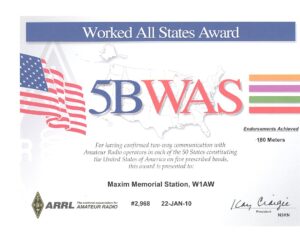2 Meter Slot Cube Antenna Arrl
I decided it was time to set up a 2 Meter base station. Being the crafty maker type, I wanted to build my own antenna. I settled on a 2 meter vertical dipole. I proceeded to make a very heavy dipole from copper pipe, akin to the type used for J-poles. It was incredibly heavy and very quickly became a sagging and corroded eyesore on the corner of my house.
I decided to go back to the drawing board and starting from scratch, designed an entirely new, much lighter, 2 meter vertical dipole. This antenna offers an air choke to keep stray RF from wondering back into the shack, since I’m pushing 65 watts. Also with vertical dipoles you want the feedline extending perpendicular to the antenna for at least 1/4 wavelength for good SWR.

Everything to make this antenna should be available at your local hardware store with the exception of the feedline and any RF connectors. You may have a lot of it laying around the shack already. I encourage you to experiment and make this design your own. Use what you already have and play around with modifications to what I’ve done.
Parts List
The antenna works well but is difficult to rotate. The photograph below shows the antenna installed at my QTH. The top spreader is 50 feet above ground. The bottom about 20 feet above ground level. HF Skeleton slot. The drawing above shows the dimensions of my Skeleton Slot. It can be easily rotated. It is bi-directional. Two Meter Antenna It’s likely your first Ham radio purchase was a 2 meter or dual-band HT. Unfortunately, the rubber duck antenna that came with it isn’t the best choice for maximum signal. If you’re tired of people telling you your signal is weak, the simplest remedy is an improved antenna. Two Meter Antenna. It’s likely your first Ham radio purchase was a 2 meter or dual-band HT. Unfortunately, the rubber duck antenna that came with it isn’t the best choice for maximum signal. If you’re tired of people telling you your signal is weak, the simplest remedy is an improved antenna.
- 3/4” PVC pipe (I grabbed one 5 foot length)
- 1” PVC pipe (I grabbed one 5 foot length)
- 1 3/4” PVC Slip 90
- 1 3/4” PVC Slip Tee
- 1 3/4” x 1” PVC Slip Tee
- 2 3/4” PVC slip plugs
- 2 steel rods roughly 1/8” and about 19″-20” long (I cut longer pieces down)
- 2 Copper Terminal Lugs (I used Thomas & Betts pn: BTC0614-B2)
- 2 small ring terminals (anything 12 to 16 AWG should work)
- 4 or 5 wire ties
- Electrical Tape
- About 3 foot of your favorite flavor of feedline(I used RG58)
- RF connector of your choice (I used a BNC for RG58)
- Nuts and bolts that fit your lugs and ring terminals
Tools Needed

- Drill with bits the size of feedline and bolts
- Dremel tool with grinding wheel or a file
- Tools required to install RF connector
- Hot Glue Gun
- SWR meter or antenna analyzer
- Solder and soldering station(optional)
- Something to cut PVC pipe(I use a metal pipe cutting tool)
The Build
I decided it was time to set up a 2 Meter base station. Being the crafty maker type, I wanted to build my own antenna. I settled on a 2 meter vertical dipole. I proceeded to make a very heavy dipole from copper pipe, akin to the type used for J-poles.
Start by aligning the terminal lugs to the outer edges of the Tee as shown in the picture, drilling holes through the pipe and bolting them into place loosely(we’ll take them back off later) The terminal lug has sort of a lip on it and I go this as close to the edge of the pipe as possible so when tight, it would help hole the lug upright. Also at this point, loosen the terminal lugs and flip the heads around 180. This allows the steel rods to go all the way through the lug instead of bottoming out and places them toward the outside of the pipe tee instead of toward the inside.
Next we cut a length of 3/4” pipe a touch longer than 1/4 wavelength, about 20 inches long and lightly push it into the remaining hole on that same tee. Then, coming back an extra half inch or so and drill a hole the size of your chosen feedline into the pipe. Test wrap about 5-7 wraps of your feedline around the pipe starting at the hole, then mark for a second hole along the same line as the first and drill one there. This will be for your air choke. Once wrapped, we can wrap the choke tightly with electrical tape to help hold it in place. Depending on how weatherproof you want this, you may opt to cover it in some type of liquid electrical tape as well.
Before you get to wrapping the coil, however, we need to push a few inches of feedline through the hole closest to the end of the pipe, and prepare the shield and center conductor for ring terminals. Leave enough insulation off to reach both bolts on the tee. Crimp a ring terminal on the center conductor and one on the shielding. At this point I soldered the ring terminals in place for added strength, and covered them in heat shrink tubing with only the ring exposed. This is all optional.
Take the nuts off of the bolts on the terminal lugs, push on the ring terminals, and replace the nuts. Tighten them down really good until the nuts start to pull into the PVC. You may opt for washers on the outside of the tee. Now push the ¼ wavelength piece of pipe into the tee very tight, and pull the excess feedling back through the hole you drilled so no excess is in the end of the antenna. Wrap 5-7 wraps and push the feedline in the second hole and out the long end of the pipe. You’ll need about 8-15 inches or so of feedling sticking out the far end. Of the pipe, for your RF Connection. Also place the 3/4″ X 1″ Tee on the other end of the pipe. Throughout the rest of this process make sure the center conductor is attatched to the element sticking up and the sheilding to the counterpoise sticking down.

Next take the two 3/4” caps and notch them out as shown and push them on over the terminal lugs. I used a dremel tool with grinding wheel for this but you may have a better option available. Cut the steel rods down to ¼ wavelength for 2 meters. This runs between 19 and 20 inches. Because we are using an inch or so of the feedline as part of the radiating element(inside the tee) I simply cut mine down to 19 inches. Do this with a dremel tool, or a file, or other tool of your choice. (Don’t ruin your wire-cutters or strippers by using them! The steel is a lot harder than it looks!) Run a steel rod into each of the terminal lugs and out the other side a half inch or so then tighten the lugs.
Cut 1-2 inches of 3/4” pipe and put it on the opposite end of the tee with a 3/4” 90 off of it and push your feedline through all this as you do it. Next cut a section of 1” pipe long enough to mount the antenna where you want and push it into the bottom of the 3/4″ X 1″ tee. Cut one last 3/4” piece of pipe about a foot or so long and hold on to it for use later.
2 Meter Slot Cube Antenna Arrl Ham Radio
Make sure all your pipe is together tight and at this point if you want to use pipe glue, do it. I opted just to use hot glue at all the seams once my antenna was completed.

Cut your feedline down so only 3 or 4 inches are coming out of the antenna and put on your RF connector of choice find a temporary stand for your antenna.(I used the base and stand of an old house fan). Using and SWR meter or an antenna analyzer, test for a good SWR on the two meter band.(I tried to center around 146MHz)
Adjust the two steel rods in or out to change SWR until you have a good match. Once matched, tighten down the terminal lug screws, and run a wire tie around the side of the tee and the stub of the steel rod sticking out the bottom of the lug. This just removes possible stress on the lug itself if it gets pushed toward the feedline end of the antenna. Seal all seams with hot glue, then mount in your permanent location. Run your extra piece of 3/4” pipe on the outgoing feedline and after connecting to your antenna, push it onto the remaining side of the 90, just using friction to hold it in place. This is the last little bit of quick and dirty waterproofing. Now use a few wire ties to tie the incoming feedling to the main mast.
2 Meter Slot Cube Antenna Arrl Radio
Hook to your base station(or HT) and enjoy! Some of the hardware may rust over time, so when the antenna gets in bad shape I’ll simple replace the bad hardware with new. It’s cheap. Otherwise you could use something to seal the exposed metal parts. I installed this in an old dish mount on the corner of my house at about 15 feet and it bought me about 25 miles extra distance over my rubber duck antennas.